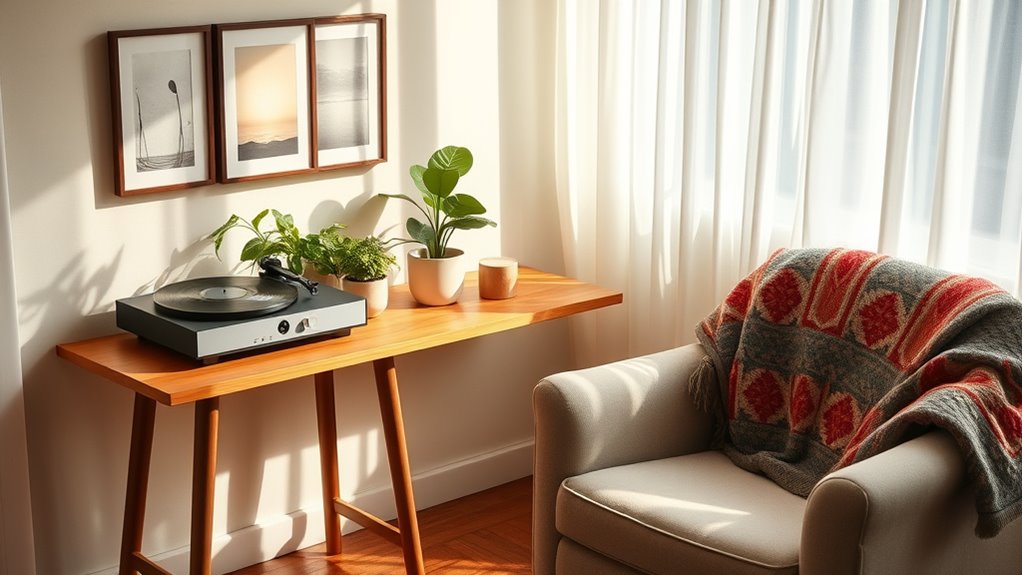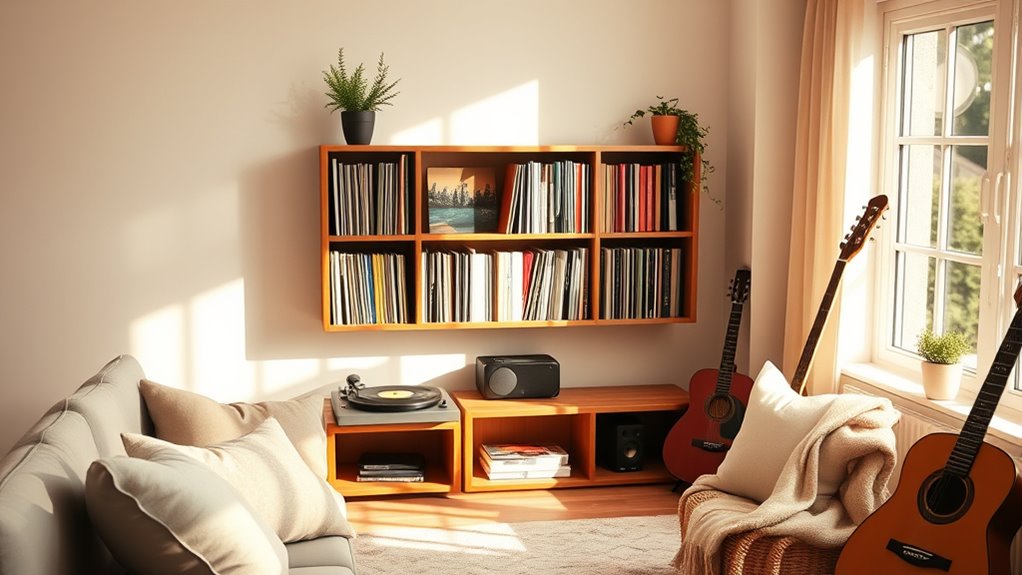Create a cozy, dedicated corner with comfortable seating or lying space, good lighting, and minimal distractions. Gather your favorite devices like smartphones or tablets with reliable internet or downloaded playlists. Curate playlists tailored for relaxation, motivation, or comfort, updating them regularly. Use noise-canceling headphones or quality speakers to enhance the sound. Establish a routine, dedicating specific times for your sessions. Keep exploring different setups and playlists—more ways to optimize your healing space await if you keep going.
Key Takeaways
- Choose a cozy, quiet space with natural light to create a comfortable environment for listening sessions.
- Use accessible devices like smartphones or tablets, ensuring playlists are downloaded and ready for seamless playback.
- Curate personalized playlists targeting specific emotional needs such as relaxation, motivation, or stress relief.
- Incorporate noise-canceling headphones or Bluetooth speakers to enhance sound quality and immersion during therapy.
- Establish a regular routine for listening sessions to promote emotional well-being and consistent therapeutic benefits.

Music therapy at home offers a convenient and effective way to improve your emotional well-being and support mental health. By creating a dedicated playlist station, you can harness the power of music to relax, uplift, and process emotions whenever you need it. Setting up this space doesn’t have to be complicated; a few thoughtful steps can turn your environment into a personalized sanctuary for healing and self-care.
Start by choosing a comfortable spot where you can sit or lie down without interruptions. It could be a cozy corner, a dedicated chair, or even a space near your window to enjoy natural light. Next, gather your preferred devices—whether it’s a smartphone, tablet, or a dedicated music player—and ensure you have reliable internet access or downloaded playlists ready to go. Having your music easily accessible is key to making this a seamless part of your routine.
Create curated playlists that resonate with your emotional needs. You might assemble calming tracks for relaxation, energetic songs for motivation, or nostalgic tunes that bring comfort. Don’t hesitate to include a variety of genres and artists; diversity can enhance the therapeutic effects. Consider organizing playlists by mood or activity, so you can quickly select the right music for the moment. For example, have a playlist for reducing anxiety, one for boosting happiness, and another for helping you unwind before bed.
Create personalized playlists for relaxation, motivation, and comfort to support your emotional well-being through music therapy.
Incorporate simple equipment that enhances your experience. Noise-canceling headphones can block out distractions and deepen your connection to the music. A Bluetooth speaker can fill your space with sound, creating an immersive environment. If you enjoy playing musical instruments or singing, keep them nearby to add a creative element to your therapy sessions. The goal is to make this setup inviting and easy to access, so you’re encouraged to use it regularly.
To make your setup even more effective, consider understanding basic sound principles like optimal volume levels and speaker placement to enhance your listening experience. Once your playlist station is ready, establish a routine. Dedicate a specific time each day or week for music therapy, whether it’s during your morning routine, lunch break, or evening wind-down. Use this time to sit quietly, focus on the music, and allow yourself to fully experience the emotional shifts it brings. Pay attention to how different songs make you feel and adjust your playlists accordingly. Over time, this personalized station becomes a powerful tool for emotional regulation, stress relief, and mental clarity, empowering you to take charge of your mental health from the comfort of your home.
Frequently Asked Questions
What Equipment Is Essential for a Home Playlist Station?
You need a good-quality speaker or headphones to guarantee clear sound, a device like a smartphone, tablet, or computer to access and manage your playlists, and a reliable internet connection if streaming. Consider having a playlist management app or music library, along with comfortable seating and a quiet space. Optional extras include a Bluetooth receiver for wireless setup and a timer to help you regulate listening sessions.
How Do I Personalize Therapy Playlists for Different Emotional Needs?
You personalize therapy playlists by selecting songs that resonate with each emotional need. Think about what comforts, energizes, or calms you, and include songs that evoke those feelings. Mix genres and tempos to match moods, and add personal favorites or meaningful lyrics. Update your playlists regularly based on your emotional responses, and keep a journal to track which songs help you feel better, making your playlists uniquely suited to your healing journey.
Can Children Benefit From a Home Music Therapy Setup?
Absolutely, children can benefit from a home music therapy setup. You might think of it as hitting two birds with one stone—boosting their mood and helping them develop emotional skills. By choosing appropriate songs and encouraging active listening, you create a safe space for kids to express feelings and relax. Just remember, the key is to keep it fun and engaging, so they stay interested and reap the benefits.
How Often Should I Update or Change My Therapy Playlist?
You should update your therapy playlist every few weeks or when you notice it’s losing its impact. Pay attention to how your child responds; if they seem less engaged or start to ignore the songs, it’s time for a change. Regular updates keep the music fresh and tailored to your child’s evolving needs, ensuring therapy remains effective and enjoyable. Don’t be afraid to experiment with new genres or calming tunes.
Are There Any Safety Considerations When Setting up a Playlist Station at Home?
Safety first, as the saying goes. When setting up your playlist station at home, you should guarantee your equipment is stable and away from water or heat sources. Keep cords organized to prevent tripping, and avoid loud volumes that could damage your hearing. Always supervise children around electronic devices, and use equipment with proper safety certifications. Taking these steps helps create a safe, healing environment for your music therapy sessions.
Conclusion
Now that you know how to set up your own playlist station, imagine the possibilities it holds. With just a few thoughtful choices, you can turn your home into a sanctuary of healing and calm. But what if the right song at the right moment could change everything? Stay tuned—your personalized music therapy journey is just beginning. The next track might be the one that transforms your day, your mood, or even your life.









